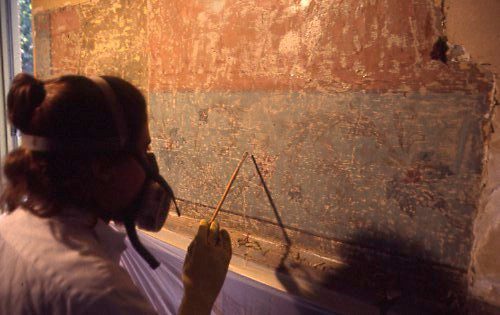How to Determine the Type of Paint Used in a Historic Building

Although the colors and styles of today may aim to replicate the appearance of earlier designs, today's paint has come a long way from the paint of our ancestors. If it weren't for the experimental painters and chemists years ago, modern paint would not have had a strong base recipe to grow on.
When performing a conservation or restoration project, it is essential to determine the original type of paint. Knowing the basic history of each kind of paint, including its intended purpose and how it behaves, is imperative to achieving the most historically accurate results.
Types of Historic Paint
Paint is a science, and historic paint is no exception. As chemists made discoveries of ingredients, paint recipes advanced to improve the quality for the consumer.
Historically, paints were separated into two basic types; oil-based paints and water-based paints. There are numerous subcategories from these main two categories, from encaustics to urethanes, from distempers to acrylics. Both paint types were named for the vehicle, or liquid medium, that carried the other components of the paint.
Oil-based paints are as they sound – based in an oil vehicle, most frequently linseed oil because of its drying properties. Water-based paints employed water as their vehicle and were most often the type of paint used for decorative work. Both paint types had their strengths and weaknesses, often involving their durability and drying proficiency. Each type of paint was used for different purposes and would be selected based on the use of the space. Some of the main characteristics of each paint type are as follows:
Oil-based paints:
-
-
- Strong and durable, slow-drying, and have a surface sheen.
- Non-vapor permeable.
- Sheen is typically high gloss unless additives, such as wax or whiting, are introduced. Or, the paint is manipulated when applied with a stipple brush to create a disbursed light refraction.
- Mainly used for wood trim and metal, however, also found on masonry and plaster surfaces.
- Become very brittle over time.
- The brittle oil tends to yellow or “amber” over time, which causes a color shift. What was once blue appears green. The shift can take decades to become evident.
- Typically include drying agents, as the oil takes a long time to dry on its own.
-
Traditional Water-based paints:
-
-
- Always flat – have no sheen or gloss.
- Vapor permeable. Often used on freshly installed plaster surfaces that have not fully cured.
- Dry as soon as the water evaporates, meaning no added drying agents are needed.
- Do not hold up well to abrasion.
- Frequently used to paint plaster wall surfaces.
- Can be used for decorative works, most notably with trompe l’oeil and grisaille decorations.
-

Determining Types of Historic Paint
Basic clues for identification can come from a few sources. These general indicators can help guide you in the right direction and hint at whether the paint you are looking at is water or oil-based.
Geographic Area:
Paints were often made with readily available ingredients and mixed by hand by a craftsman. The geographic area in which the building sits determines the different available components, and microscopic analysis of the paint would uncover the included ingredients. Generally, early structures in the southwest United States contained decorative designs done in water-based paints. It was common to find oil-based paints applied to wood trim in the northeastern states. The warmer and more tropical regions, such as Galveston, Miami, New Orleans, Puerto Rico, and Cuba often employed pigmented masonry washing, such as lime. The Germans developed mineral silicate paint for masonry. These will be explored in a forthcoming paper.
Substrate Painted:
Water-based paints were often used for decorative work and frequently covered interior plaster walls, while painters commonly used oil-based paints on wood trim and metal.
These indicators can provide insight into the history of paint; however, the most accurate identification method is a paint study. When coupled with in-depth research, a paint study can uncover the most valuable information about a building and its paint’s history. Paint investigation provides great value to a project. It can be the key to identifying the types and colors of the paints and the root causes of paint failure, which can help create a treatment plan to implement during a preservation project.
Overall before (Left) and after (Right) restoration at Norwich’s Cathedral of St. Patrick. The restoration process included exposures of original finishes, extract and preparing cross section samples for analysis to establish the relationship between paint campaigns and original color palette.
Understanding a Historic Paint Study
During a historic paint study, you can expect experts to take paint samples from multiple locations in the building, then analyze them using microscopy in a laboratory setting. Experts will look for evidence of binders, pigments, and possible glazes. Analysis may include Fourier-transform infrared spectroscopy (FTIR), which definitively determines the compounds in paint. Based on the type of binder identified and the dispersion of pigment particles, the specialist can determine the kind of paint. The best results will be provided by analyzing paint samples in a lab, where professionals can use complex tools and methods to uncover the history of the paint.
Although paint investigation is an exciting task, it can sometimes become dangerous. Lead is a very common pigment in historic paints and can threaten your health and safety if not adequately addressed by an industry professional.
When it comes to identifying historic paints, you should not go it alone. The best way to ensure a safe and successful project is to hire a qualified professional to conduct a paint study. You can then be sure that the preservation project will result in high-quality, safe, and accurate work.





